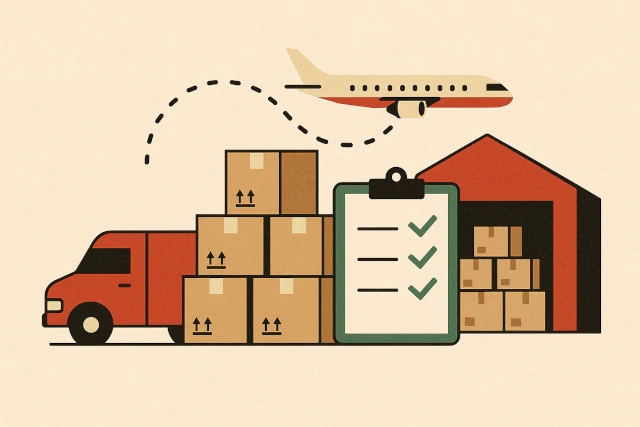CPG Distribution 101 - Guide for Early-Stage Founders

If you're just starting a CPG (consumer packaged goods) brand, distribution can feel like a black box. You’ve got a great product, maybe a few sales, but no idea how to ship efficiently—or whether you should be using Canada Post, UNFI, a courier, your own trunk, or something else entirely.
This guide is built for you—the founder packing boxes at midnight. Whether you’re making salsa in a shared kitchen or launching a snack brand from your condo, this article is a complete walkthrough of your options. It’s the CPG distribution manual I wish I had when I started out.
What is Distribution, Really?
At its core, distribution is how your product gets from where it’s made to where it’s sold—and that could be a retail shelf, a customer’s doorstep, a foodservice kitchen, or an Amazon warehouse. Distribution covers storage, transportation, fulfillment, and sometimes even invoicing and merchandising.
Basic Definitions
- Direct-to-consumer (DTC): Shipping directly to customers who buy online (e.g., Shopify orders).
- Direct-store-delivery (DSD): You deliver to stores yourself or with your own drivers.
- Distributor: A third-party company that buys, stores, and delivers your products to retailers or foodservice customers.
- 3PL (Third-Party Logistics): A warehousing and shipping service that stores and fulfills your orders but doesn’t sell for you.
- Freight: Bulk shipping of large quantities—often palletized—to warehouses, distributors, or retailers.
Very Small Brands: How to Ship When You're Just Starting
Let’s say you’re just launching. You’ve got your first 100 units and some early orders trickling in. Here's what you need to know:
1. Pack and Ship From Home (Yes, Really)
Most CPG founders begin by shipping orders from their own home, storage unit, or commissary kitchen. It’s scrappy—but it works.
You’ll need:
- Basic materials: Boxes, tape, labels, printer, scale.
- Shipping software: Platforms like ShipStation, Chit Chats (Canada), or Pirate Ship to get discounted shipping rates.
- Carriers: Start with Canada Post, USPS, or UPS. Use drop-off if your volume is low, or schedule pickups once you’re doing 5–10 orders per day.
This is a great time to learn the rhythm of fulfillment, understand your true packaging costs, and refine your systems. Don’t outsource too early—you’ll just mask inefficiencies.
2. Deliver to Local Stores Yourself
Many first retail accounts are local independents. Delivering yourself (DSD) gives you:
- Relationship-building face time with the buyer
- Control over shelf presentation and restocks
- No distribution fees
Use your car, store products in your garage, and build your first 10–20 retail doors manually. This teaches you invaluable logistics habits and keeps you grounded in unit economics.
Comparison Table: Distribution Methods
| Method | Best For | Startup Cost | Pros | Cons |
|---|---|---|---|---|
| Self-fulfillment (Home) | First 6–12 months | Very Low | Cheap, flexible, educational | Time-consuming, manual errors |
| DSD (Deliver Yourself) | Local retailers | Low–Medium (vehicle, fuel) | Strong store relationships | Not scalable, geography-limited |
| Courier Services (Canada Post, UPS) | DTC & indie retailers | Low–Medium | Nationwide reach | High unit shipping cost |
| 3PL (Fulfillment Center) | 100+ orders/month | Medium–High | Saves time, scalable | Less control, fees add up |
| Distributor | Chain retail, 30+ doors | Medium–High | Retailer access, logistics included | 20–30% margin loss, slow pay |
| Own Truck/Drivers | Dense urban routes | High | Full control | Capital intensive, risky |
When to Graduate to a 3PL
Once you’re doing more than 100 orders/month or spending 10+ hours/week packing boxes, it’s time to consider a 3PL. These services store your product and ship out orders for you—both DTC and wholesale.
Before switching, ask:
- Are my unit margins strong enough to afford pick/pack fees?
- Is my inventory well-organized and barcoded?
- Do I have consistent velocity to justify storage costs?
Distributors: When (and If) to Use Them
Distributors are tempting. They offer access to hundreds of retailers and eliminate the need to deliver and invoice manually. But they’re not a shortcut. Here's when it makes sense:
- You’ve proven strong pull-through in 20–30 doors already
- You’re landing chain stores that mandate distributor use
- You’re ready to spend on trade spend, promos, and broker support
Warning Signs You’re Not Ready
- You haven’t built DSD or small retailer momentum
- Your product needs constant hand-selling or education
- You can’t afford 25% margin loss + promotions + broker fees
What About Foodservice Distributors?
Foodservice (cafes, caterers, institutions) can be a surprisingly profitable early channel—especially if your product works in bulk (e.g., granola, sauces, frozen). Many brands ignore it, but it’s worth testing.
To succeed here:
- Offer foodservice-format SKUs (e.g., 2kg tubs)
- Get your nutritionals and spec sheets in order
- Use food brokers with foodservice experience
Key Takeaways
- Start lean: Pack and ship from home to understand costs and operations.
- Stay close to the product: Deliver locally yourself at first—there’s no better way to learn.
- Don’t overbuild: Don’t buy a truck or warehouse until you’ve maxed out simpler options.
- Only use distributors when ready: You need velocity, retail demand, and margin to handle the cost.
- Foodservice is underrated: Explore early, especially if your product works in bulk.
Suggested Milestone Roadmap
- 0–6 Months: Self-ship DTC + deliver to 5–10 local retailers.
- 6–12 Months: Upgrade to shipping software, possibly 3PL; hit 20+ stores.
- 12–18 Months: Add regional distributor(s); start foodservice pilots.
- 18–36 Months: Explore national distributors, scale 3PL, and manage full supply chain cost model.
Remember: growth is a logistics problem as much as it is a sales problem. Mastering distribution early means fewer headaches and more margin down the road.
Good luck out there—and don’t forget to double tape your boxes!









